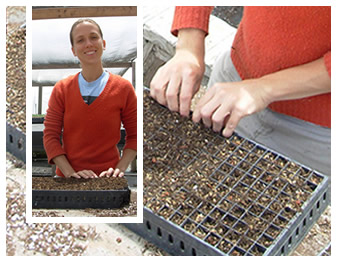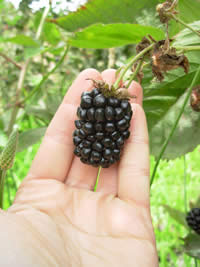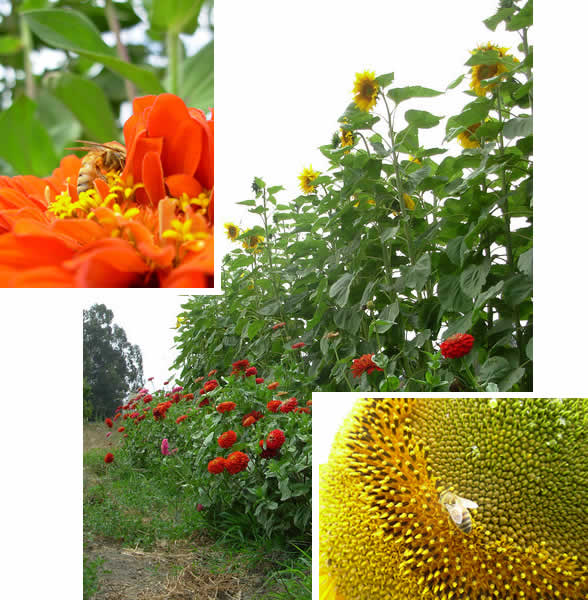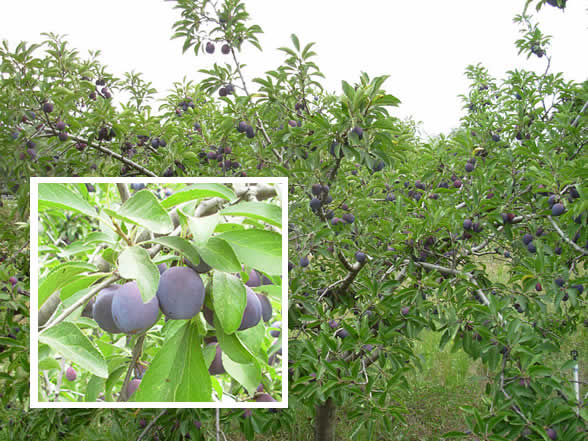|
What's in the box this week
~~~~~~~~~~~~~~~~~~~~~~~~~~~~~~~~~~~~~~~~~~~~~~~~
Content differences between Family and Small
Shares are in red; items
with a "+" in
Family Shares are more in quantity than in Small; anticipated quantities, if
any, are in parentheses, as are the source of any produce if not from Live Earth
Farm (LEF). Occasionally content will differ
from this list (typically we will make a substitution), but we do our best to
give you an accurate projection.
[go to recipe database]
Family Share
Arugula +
Basil
Broccoli + (from Lakeside Organic Gardens)
Carrots
Cucumbers
Kale
Lettuce
Peppers (sweet) +
Potatoes +
Spinach
Summer squash +
Strawberries (see checklist for quantities)*
Small Share
Arugula
Broccoli (from Lakeside Organic Gardens)
Carrots
Chard
Cucumber
Lettuce
Peppers
Potatoes
Spinach
Summer squash
Strawberries (see checklist for quantities)*
Extra Fruit
Strawberries, caneberries [i.e. either blackberries or raspberries], and plums (see checklist for quantities)*
Fruit Bounty
Strawberries and plums (see checklist for quantity)*
*The upper right-hand corner of checklist now lists how much of each fruit item comes with each share part!
|
|
"Postcard" from Farmer Tom
~~~~~~~~~~~~~~~~~~~~~~~~~~~~~~~~~~~~~~~~~~~~~~~~ Greetings from the French countryside! We, the entire Broz family, have been winding our way down the Loire and Cher Rivers to the Atlantic coast, where the landscape is peppered with chateaus, medieval castles, and old farmhouses surrounded by fields of wheat, sunflowers, corn, pastures, vineyards and forests. One of our highlights was a short stay (one night) on Ile de Re, a popular summer vacation island for French families. The most popular way to explore the island is by bike, so it was fun to leave the car behind and explore the coastline via miles of scenic bike paths. On one stretch the bike path we came right alongside the beach, where farms not only are comprised of vineyards and fields, but continue right into the water - literally. I caught a farmer driving his tractor right out into the ocean at low tide to tend his oysters plots. He was proud of his tractor, which he told Constance (who took the pictures) he's had for over twenty years. Quite a feat, given the corrosive conditions of the sea.

The food is of course an adventure in itself, and best of all I get to spend time with my entire family. I am extremely grateful to be able to leave the farm for these few days; one thing is for sure, I will not only have gained some rest but a few healthy calories as well. See you all soon back on the farm.
- Tom
|
|
What's Up in the Greenhouse
~~~~~~~~~~~~~~~~~~~~~~~~~~~~~~~~~~~~~~~~~~~~~~~~  Although Farmer Tom is away on a (much needed) family vacation, we here on the farm are not resting! In addition to their other many tasks, Gillian and Arminda (pictured at right), our two farm interns, have been busy sowing the seeds for winter crops (yes winter, already! Gives you some idea of how far in advance these things need to be planned!). Although Farmer Tom is away on a (much needed) family vacation, we here on the farm are not resting! In addition to their other many tasks, Gillian and Arminda (pictured at right), our two farm interns, have been busy sowing the seeds for winter crops (yes winter, already! Gives you some idea of how far in advance these things need to be planned!).
To give you an idea of how much work sowing really is, I [Debbie] asked Gillian to elaborate. She says they have been sowing 60 flats twice a week for 2 weeks now... and will continue at this rate through the end of August (again, this is just for the winter crops). Now if you've ever seen seed flats, this is no minor undertaking!
Each flat contains 300 cells, and one seed needs to go in each cell.
Multiply that by 60, twice a week, and you start to get the picture.
What's in the pipeline for winter then, you might ask? Let's see... bunching onions, Brussels sprouts, four kinds of cabbage (including Napa), broccolini, collard greens, cauliflower, kale, chard and kohlrabi so far...
|
|
Out of the mouths of babes...
~~~~~~~~~~~~~~~~~~~~~~~~~~~~~~~~~~~~~~~~~~~~~~~~ This little gem was part of a recent request to be on our 2009 waiting list:
Learned about us: We subscribed [to your CSA] back when you dropped off at the Willow Glen Farmers Market. Took a few years off since we couldn't finish the share before spoiling, and at the time, there wasn't a small share option. Our kids' tummies are bigger now and can help with the eating, so we'd like to come back!
Comments: During our first go-round with LEF, our son was learning to talk. When he wanted something, like milk, he'd say, "Milk me!" Or "bread me", or "carrot me", etc. When beets were introduced to our share, we had to close the windows for fear of neighbors hearing, "Beet me! Beet me!" (Beat me!)
|
| Pictures from around the farm
~~~~~~~~~~~~~~~~~~~~~~~~~~~~~~~~~~~~~~~~~~~~~~~~
Many thanks to Gillian for providing this week's photos in Tom's absence!
 A swallowtail butterfly basks in the heat of the greenhouse.  Not an optical illusion... this is an adult-size hand!  A fabulous floral hedgerow at the farm -- and the happy pollinators it attracts!  And our beautiful, ripe prune plums! (you can almost taste them!!) |
|
Notes from Debbie's Kitchen
~~~~~~~~~~~~~~~~~~~~~~~~~~~~~~~~~~~~~~~~~~~~~~~~ Click here to go to recipe database.
Heard back from a few folks on the subject of leftovers and soup stock (click here if you missed last week's discussion but would like to read it now) -
From member Sara Lyon:
"With regards to leftovers: I used to struggle with the idea of what to pack in lunches for the kids. Both my son, in high school, and my husband have access to microwaves in the lunchroom. Now, every dinner includes at least enough for a couple of lunches. When we clean up after dinner, the food is packed into single serving containers, ready to be tossed into a lunch bag in the morning. Lunch is no longer an issue. Add some fruit or cookies and it's done."
And from a friend of the farm and avid newsletter reader, Dori Sage (who lives down in Southern CA but wishes she lived in the area and could get our CSA share!):
"Your mention of using leftover rice brought to mind a tip that I wanted to share with you. I only use brown rice, and have a nice 10 cup rice cooker that I love to use. Here's what I do to save time and money. I cook 10 cups of rice at the same time because even with the rice cooker, it takes probably 2-1/2 to 3 hours with soaking time. In that we are only the 2 of us in our household, I use what I want for the first night, take out some for the next night to make fried rice, then spread the rest out to cool on a baking sheet. When cool, I bag it in little freezer bags in maybe 1 to 1-1/2 cup increments and freeze. When we want rice, there it is already cooked. I heat it in the microwave on defrost setting for 2 to 3 minutes or just leave on the counter until it defrosts."
Boy, it would be a whole different world to live in if we didn't have freezers and refrigeration...! So much to be thankful for.
And here, as promised, is the 'recipe' (more like instructions, really) for making "found" stock:
Basic Found Vegetable Stock
from a book called "Dairy Hollow House Soup & Bread - A Country Inn Cookbook" by Crescent Dragonwagon [my comments in square brackets - Debbie]
"The previous stocks [in the cookbook] are reliable because they use set, measured ingredients. I love them, and use them when I have to be absolutely certain of the flavor of my finished stock at the restaurant. But the truth is at home I make another kind of vegetable stock far more often: this found stock, made almost entirely from vegetable scraps. Though it changes character depending on what scraps are used, it is almost always good if you follow the guidelines given below. Despite its amenability to changes, it is rarely incompatible with a finished soup.
"Accumulate ingredients over a few days to a week in a plastic bag in the fridge [or in the freezer for longer, which is what I do, along with various bones and meat scraps]. Quantities are not remotely relevant to a stock like this."
8 to 10 cups of carrot tops, onion peels, pea pods or their trimmings, string bean ends, celery trimmings, stem ends of squash and tomatoes, insides of any sweet peppers, apple or pear cores, stems of greens and so on [I've used fennel tops, rutabaga peels, potato peels, chard stems, parsley that is getting old and might not be otherwise used before it goes bad, and the stalks of young onions and green garlic] - anything except the cruciferous vegetables [see last week's recipe section where I mention this].
1 whole head of garlic, papery skin left on, broken in half
1 onion, quartered (unpeeled unless there are lots of onion ends and peels in your stock)
Spring water to cover
1 to 1 ½ tbsp. salt, approximately, per quart of water
1. Bring all ingredients to a boil in a pot that will fit them. Turn down the heat to medium-low and let simmer gently, uncovered, for 1 hour or so.
2. Cool to lukewarm, then strain. Use immediately, or store in fridge or freezer.
[The only thing I would add to this is, if your 'found stock' bag includes meat or chicken bones, add a couple blubs of vinegar (I use raw, unfiltered apple cider vinegar), to extract the nutritious calcium and minerals, and simmer it longer - from a couple hours to several hours, if you have lots of bones. See a cookbook called "Nourishing Traditions" by Sally Fallon for more info on this topic.]
Member Pia Chamberlain wrote me with this added bit of info:
"On the subject of stock -- a trick I learned from Crescent Dragonwagon in her vegetarian cookbook [same author; in Soup & Bread she covers this in more detail under the heading Stock-Enriching Ingredients] -- add about 1/2 Tablespoon of white miso and about 1/8 cup of brewers yeast (she says 1/4 cup but I find that to be too much). This creates a lovely full-bodied vegetarian stock that enhances any soup you make from it. (And increases its nutritional value at the same time.)"
OH, and a lovely little sidebar in 'Soup & Bread' provided this gem she called Stock Options:
"Short on freezer space, yet want to have good homemade stock on hand? Prepare any stock and, after it has been strained [and defatted, if making a chicken or meat stock], return it to the stockpot. Raise the heat and bring the stock to a hard boil. Allow it to evaporate by half. Bring the reduced stock to room temperature, then freeze it in an ice cube tray. When the cubes are frozen, pop them out of the tray and store in a sturdy plastic bag, such as a Ziploc.
"Use 1 cube at a time, diluting each cube with ¼ to ½ cup spring water, wine, vegetable cooking water, or tomato juice. Or use the cubes without dliuting, as a flavor booster any time a finished soup tastes a bit pallid."
Here's a recipe I see I've had in my 'recipe ideas' file from 5 years ago (!) (When you guys email me with recipes and I'm unable to use them that week, I save them for future reference.) This was sent to me by Linda Caplinger, who said, "I have also made this with green Swiss chard when there wasn't any arugula around, and that worked as well. I don't eat land animals & dairy products so I make this vegan style with veggie broth and skip the parmesan oil. It's still delicious."
White Bean, Potato and Arugula Soup
Bon Appétit, December 2001 (edited very slightly)
serves 8 as a first course, or 4 as a main
Start this recipe a day ahead so that there's time for the beans to soak overnight.
soup ingredients:
1 lb. dried Great Northern Beans
2 bay leaves
6 tbsp. olive oil
3 large fresh rosemary sprigs
1 lg. russet potato, peeled, cut into 1/2-inch pieces (about 2 C) [just use the farm potatoes - doesn't have to be russet!]
10 garlic cloves, chopped
6 C (or more) chicken or vegetable stock/broth
about 3 C arugula leaves**, torn or cut into bite sized pieces
1 tsp. dried crushed red pepper
parmesan oil ingredients (optional):
2/3 C (packed) grated Parmesan cheese (about 2 1/2 oz.)
1/4 C plus 2 tbsp. olive oil
Place Great Northern beans in large pot. Pour enough water over beans to cover by 4 inches. Let soak overnight. Drain beans and return to pot. Pour enough water over beans to cover by 4 inches. Add 2 bay leaves and bring to boil. Reduce heat to medium-low. Add 3 tablespoons olive oil and fresh rosemary sprigs and simmer uncovered until beans are barely tender, about 30 minutes.
Heat 3 tablespoons olive oil in another large pot over medium heat. Add potato pieces and sauté until brown in spots, about 8 minutes. Add half of garlic and sauté until beginning to color, about 3 minutes. Add 6 cups chicken stock and boil until potato pieces are falling apart, about 10 minutes. Pour beans and cooking liquid into potato mixture. Bring to boil; reduce heat and simmer just until beans are tender, about 10 minutes. Season soup generously with salt and pepper. (Soup can be prepared up to 2 days ahead. Cool slightly, then cover and refrigerate. Bring to simmer before continuing, thinning with additional chicken stock if necessary.)
For parmesan oil:
Blend 2/3 cup grated Parmesan cheese and 1/4 cup olive oil in processor until smooth. (Parmesan oil can be prepared 1 day ahead. Cover oil and refrigerate.)
Stir arugula into soup. Heat remaining 2 tablespoons olive oil in heavy small skillet over medium heat. Add remaining chopped garlic and dried crushed red pepper; sauté until golden. Add to soup and simmer 5 minutes. Stir Parmesan oil into soup. Season soup to taste with salt and pepper.
**When unavailable, Swiss chard is a great substitution. Remove thick vein in the middle of the leaves, slice into 1/2 to 1" wide strips. You may need to add a little cooking time to ensure that the chard is cooked through.
And lastly, here are two more recipes from the 'Ideas' archive, sent to me by member Barbie Aknin:
Zucchini Almond Salad
Grate 4 zucchini and sprinkle with 3 tbsp. kosher salt. Let drain in a sieve over a bowl for 30 to 45 minutes. Rinse well in cold water. Squeeze as much liquid out of the zucchini as you can (patting it between paper towel helps) and place it in a bowl. Drizzle with 2 to 3 tbsp. olive oil, the zest of 1 lemon and the juice of 1 to 2 lemons. Sprinkle with toasted sliced almonds. Serve as a side dish or appetizer with toasted baguette. I also use it with pasta... Prepare the salad without the oil and almonds. Cook a box of pasta. While the pasta is boiling heat the olive oil and sauté the almonds. Toss the pasta, salad and warm oil and nuts. Needs no cheese.
Zucchini Chocolate Cake
Butter and flour a bundt style pan. Preheat oven to 350F.
Sift and set aside:
2 1/2 C flour
2 1/2 tsp. baking powder
1 1/2 tsp. baking soda
1 tsp. salt
1 tsp. cinnamon
1/2 C unsweetened cocoa powder
Cream together in a bowl:
3/4 C unsalted butter
2 C sugar
Add and beat until fluffy:
3 eggs, one at a time
Add just until blended:
2 C packed grated zucchini
2 tsp. grated orange rind (optional)
2 tsp. vanilla
Add flour mixture alternately with 1/2 C milk beginning and ending with flour. Add 1 C nuts (optional)
Bake for about 1 hour and fifteen minutes. Cool 10 minutes. Turn out. Cool to room temp.
Glaze with:
2 C powdered sugar
3 tbsp. lemon or orange juice
1 tbsp. grated rind of lemon or orange
|
| CALENDAR OF EVENTS
~~~~~~~~~~~~~~~~~~~~~~~~~~~~~~~~~~~~~~~~~~~~~~~~
For details on events listed below, please Click here to go to the calendar page on our website.
Fall Equinox Cob Building Workshop and Campout - Sept. 20 and 21
Fine Farm Feast - postponed to 2009
Fall Harvest Celebration - Saturday Oct. 11th (more details as it gets closer!)
Banana
Slug String Band Benefit Concert for Live Earth Farm Discovery Program -
Saturday Nov. 22, 11am and 1pm at the Kuumbwa Jazz Center in Santa
Cruz
|
|